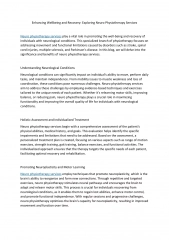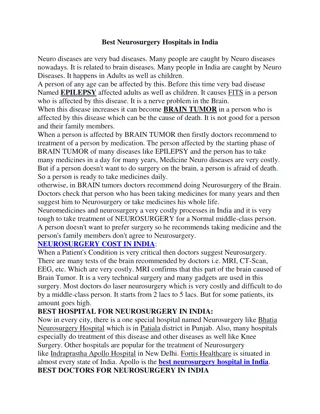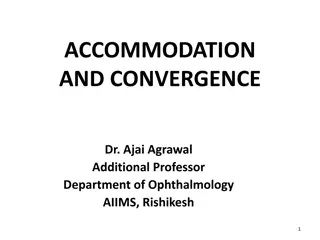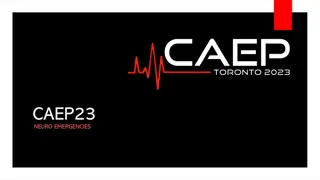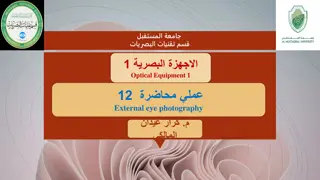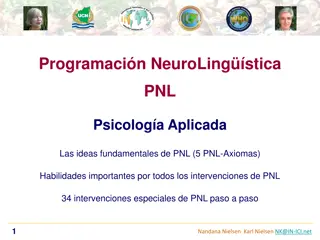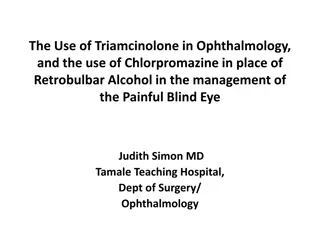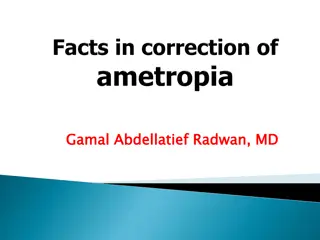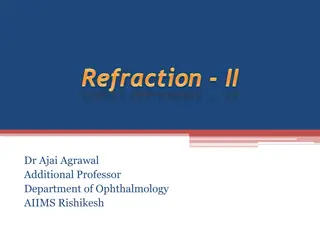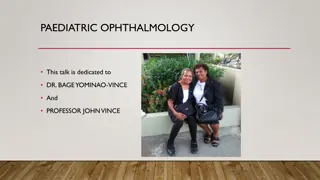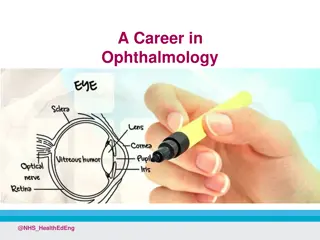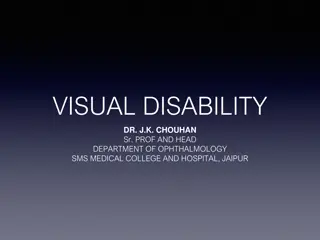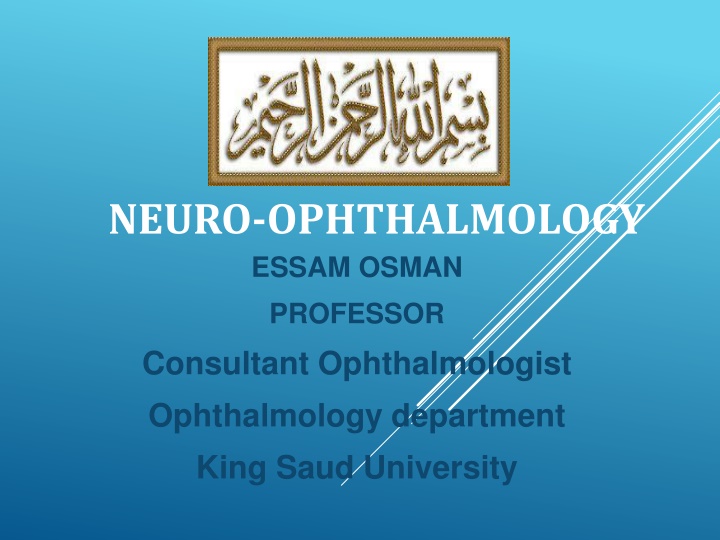
Pupillary Disorders in Neuro-Ophthalmology
Explore the intricate world of pupillary disorders in neuro-ophthalmology, delving into the anatomy, physiology, and examination of the pupil. Learn how to identify abnormal pupils and the underlying pathways involved in pupillary control.
Download Presentation

Please find below an Image/Link to download the presentation.
The content on the website is provided AS IS for your information and personal use only. It may not be sold, licensed, or shared on other websites without obtaining consent from the author. If you encounter any issues during the download, it is possible that the publisher has removed the file from their server.
You are allowed to download the files provided on this website for personal or commercial use, subject to the condition that they are used lawfully. All files are the property of their respective owners.
The content on the website is provided AS IS for your information and personal use only. It may not be sold, licensed, or shared on other websites without obtaining consent from the author.
E N D
Presentation Transcript
NEURO-OPHTHALMOLOGY ESSAM OSMAN PROFESSOR Consultant Ophthalmologist Ophthalmology department King Saud University
Neuro-ophthalmolgy deals with ocular problem caused by disorder of brain, optic nerve, Cranial Nerves and pupil pathway.
PART 1: PUPILLARY DISORDERS
Anatomy and physiology: The pupil size is controlled by a balance between parasympathetic innervation to the sphincter muscles and sympathetic innervation of the dilator muscles of the iris. Pupil construct to light and near stimuli. PUPILLARY DISORDERS
Sympathetic( adrenergic) pathway: Pupillary dilation is mediated through three- neuron sympathetic(adrenergic) pathways that originate in the hypothalamus. PUPILLARY DISORDERS
PUPILLARY DISORDERS: PARASYMPATHETIC(CHOLINERGIC) PATHWAY:
Examination of the pupil: Best conducted in dim light room using a bright light The patient should be relaxed and fixing on a distant object. The size, shape and position of each pupil should be noted in light and dark condition. Check light reflex looking for a relative afferent pupillary defect(RAPD) PUPILLARY DISORDERS
When the small pupil does not dilate as well as the large pupil in dim light, then the small pupil is abnormal. When the larger pupil does not constrict as well as the small pupil in response to a light stimulus, then the large pupil is abnormal PUPILLARY DISORDERS
The large pupil is abnormal: Previous ocular surgery Ocular trauma Use of medications like cycloplegics e.g. atropine, cyclopentolate Third nerve palsy Tonic pupil (Adie's pupil) PUPILLARY DISORDERS
Tonic pupil (Adie's pupil) Young women Unilateral Light reaction is diminished or absent Installation of weak cholinergic agents (0. 1% pilocarpine) will cause constriction of the tonic pupil (denervation hypersensitivity) Benign condition PUPILLARY DISORDERS
The small pupil is abnormal: Previous ocular surgery Ocular trauma or inflammation Use of medication e.g. pilocarpine Horner syndrome PUPILLARY DISORDERS
The small pupil is abnormal: Horner syndrome: Small pupil, ptosis and anhydrosis Caused by a lesion anywhere along the sympathetic pathway Carotid dissection, carotid aneurysm and tumor can be associated with this syndrome PUPILLARY DISORDERS
PART 2: NEUROMOTILITY DISORDERS
Third cranial nerve (oculomotor) : Begins as a nucleus in the midbrain that consists of several subnuclei that innervate the individual extraocular muscles, the eyelids, and the pupils. NEUROMOTILITY DISORDERS
Third cranial nerve (oculomotor)palsy: 65 yrs old presented complaining of double vision NEUROMOTILITY DISORDERS
Third cranial nerve (oculomotor)palsy : Check for pupil involvement NEUROMOTILITY DISORDERS
Third cranial nerve (oculomotor)palsy : Etiology: intracranial aneurysm (posterior communicating artery ) micro-vascular ischemia ( DM and HTN) trauma brain tumor NEUROMOTILITY DISORDERS
Fourth cranial nerve (trochlear) palsy: Vertical diplopia Head tilt to the opposite shoulder Etiology: Trauma Idiopathic Congenital NEUROMOTILITY DISORDERS
Sixth cranial nerve(abducens)palsy: Horizontal diplopia (worse at distance) Esotropia Face turn in the direction of the paralyzed muscle Limited Abduction on the side of the lesion NEUROMOTILITY DISORDERS
Sixth cranialnerve(abducens)palsy: causes : Intracranial tumors Trauma Microvascular diseases Increased intracranial pressure NEUROMOTILITY DISORDERS
PART 3: NEUROMUSCULAR DISORDER
Ocular myasthenia gravis Chronic autoimmune disease affecting the neuromuscular junction in skeletal muscles. Ptosis Diplopia Fatigability and variability of clinical findings are characteristic The pupil is not affected NEUROMUSCULAR DISORDER
Ocular myasthenia gravis Check for systemic weakness, difficulty in swallowing or breathing. Assess orbicularis strength Blood test for acetylcholine receptor antibodies NEUROMUSCULAR DISORDER
Ocular myasthenia gravis (OMG): Tensilon test: inhibits acetylcholinesterase and can transiently reverse signs of weakness due to OMG, such as ptosis and extra-ocular muscle paresis. NEUROMUSCULAR DISORDER
PART 4: VISUAL PATHWAY DISORDERS
Optic nerve disease: Usually unilateral Afferent pupillary defect Central visual loss Loss of color vision Optic disc edema Optic atrophy VISUAL PATHWAY DISORDERS
Optic nerve disease: Optic neuritis : Inflammatory demyelinating condition associated with MS Most common type in young adults The visual acuity is markedly reduced and an afferent pupillary defect is present. Associated with pain on extra-ocular muscle movement in 90% of patients Good recovery IV steroids my speed up the recovery process but does not influence the final outcome VISUAL PATHWAY DISORDERS
Ischemic optic neuropathy (ION): Non-arteritic ION: Patients usually have DM,HTN and other vascular risk factor. Most common cause in older patients Altitudinal visual field loss VISUAL PATHWAY DISORDERS
Ischemic optic neuropathy (ION): Arteritic ION: >65yrs old Associated with giant cell arteritis (GCA) Check for jaw claudication, proximal myalgia and arthralgia, scalp tenderness, headache Elevated erythrocyte sedimentation rate (ESR) and C- reactive protein (CRP) VISUAL PATHWAY DISORDERS
Ischemic optic neuropathy (ION): Arteritic ION: Temporal artery biopsy is the gold standard for diagnosis. Systemic steroids is given immediately if GCA is suspected. Binocular involvement occurs in a third of cases, often within the first day. VISUAL PATHWAY DISORDERS
Optic nerve disease: congenital disc elevation: <1% optic disc margins blurred and the cup is absent but no edema or hrg can be observed. may be associated with hyperopia or drusen. VISUAL PATHWAY DISORDERS
Optic nerve disease: Other causes of optic neuropathy: Infection e.g viruses, TB, cryptococcus and syphilis Systemic connective tissue disease e.g SLE genetics : Leber s opticc neuropathy (through a mitochondrial DNA mutation) Toxic and nutritional deficiencies Trauma VISUAL PATHWAY DISORDERS
Papilledema Bilateral swelling of the optic discs secondary to increased intracranial pressure. VISUAL PATHWAY DISORDERS
Hyperemia of the disc. Tortuosity of the veins and capillaries. Blurring and elevation of disc margins. Per papillary flame shaped haemorrhages. VISUAL PATHWAY DISORDERS
Papilledema Causes: Intracranial mass Sever systemic hypertension Idiopathic intracranial hypertension (pseudo- tumor cerebri) VISUAL PATHWAY DISORDERS

